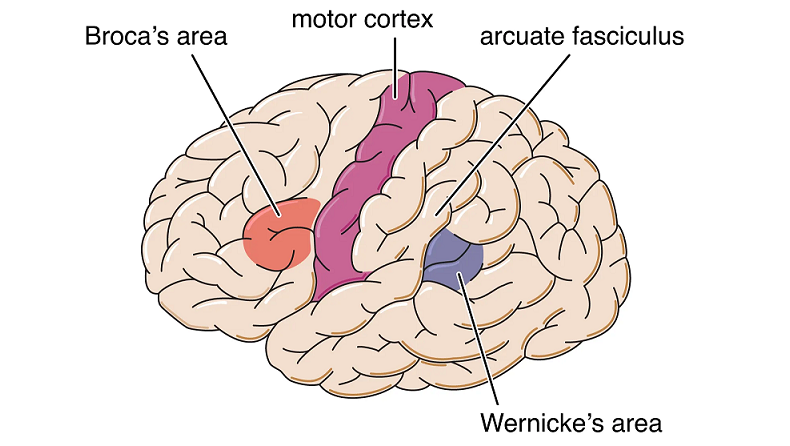
Often overshadowed by more commonly discussed parts of the brain, the Arcuate Fasciculus plays a crucial yet understated role in our ability to communicate. It’s a neural pathway that acts as a hidden highway for language processing, connecting various regions of the brain to enable both the comprehension and production of language. Here we examine how the Arcuate Fasciculus connects different parts of our brain, its significance in understanding and producing speech, and the impact it has when impaired.
Contents
Basic Brain Anatomy
Before getting into the specifics of the Arcuate Fasciculus, it’s essential to understand where it fits within the broader context of brain anatomy. The human brain, a complex and intricately wired organ, consists of various regions and pathways that interact to govern our abilities and behaviors. The Arcuate Fasciculus is one such pathway, nestled within this complex network, playing a pivotal role in our linguistic capabilities.
Location of the Arcuate Fasciculus
The Arcuate Fasciculus is a bundle of nerve fibers located in the brain’s left hemisphere, which is predominantly responsible for language skills. This bundle connects two critical areas: the Wernicke’s area, involved in language comprehension, and the Broca’s area, essential for speech production. Situated deep within the brain, this white matter tract serves as a bridge facilitating communication between these two vital regions.
Arcuate Fasciculus Connection to Other Brain Regions
While its primary connection is between the Broca’s and Wernicke’s areas, the Arcuate Fasciculus also extends its reach to other parts of the brain. It interacts with various cortical areas involved in language processing, including the auditory cortex, which processes sound, and the motor cortex, which plays a role in speech articulation. This extensive connectivity underscores its importance in the integrated process of understanding and producing language.
Structural Composition of the Arcuate Fasciculus
The Arcuate Fasciculus is composed of myelinated axons. These are nerve fibers covered in myelin, a fatty substance that insulates the fibers and significantly enhances signal transmission speed. This myelination is crucial for the rapid processing required for fluent speech and language comprehension. The density and organization of these fibers can vary from person to person, influencing individual differences in language ability and learning [1].

The Arcuate Fasciculus and Language
Having established its location and structural composition, we now turn to the pivotal role the Arcuate Fasciculus plays in language. This neural pathway is not just a physical structure but a dynamic bridge essential for the intricate process of language processing and production.
Arcuate Fasciculus Role in Language Comprehension
The Arcuate Fasciculus is instrumental in language comprehension. It facilitates the transfer of processed language information from Wernicke’s area, which is involved in understanding spoken and written language, to other brain areas. This transfer is critical for interpreting and making sense of the words we hear or read. Disruptions in this pathway can lead to difficulties in understanding language, known as receptive aphasia, where individuals might hear words but cannot grasp their meaning.
Involvement of the Arcuate Fasciculus in Language Production
In addition to comprehension, the Arcuate Fasciculus plays a key role in language production. It connects Wernicke’s area to Broca’s area, which governs the motor functions involved in speech. This connection ensures that the language we understand can be translated into coherent speech. When this pathway is impaired, it can result in expressive aphasia, where individuals know what they want to say but struggle to articulate their thoughts into words [2].
Differences in Bilingual and Monolingual Brains
The structure and functioning of the Arcuate Fasciculus also exhibit fascinating variations between bilingual and monolingual individuals. Studies have shown that bilingual individuals often have a more robust Arcuate Fasciculus. This enhanced development is thought to result from the increased demands of managing two languages, which may lead to greater flexibility and efficiency in language processing. Such findings highlight the Arcuate Fasciculus’s adaptability and its critical role in complex language tasks.
Disorders Associated with the Arcuate Fasciculus
The Arcuate Fasciculus, pivotal in language processing, also plays a significant role in various language disorders when its function is compromised. Understanding these disorders not only highlights the importance of this neural pathway but also sheds light on the complexity of language processing in the human brain.
Arcuate Fasciculus and Aphasia and Speech Impairments
One of the most notable disorders associated with the Arcuate Fasciculus is aphasia, specifically Conduction Aphasia. This condition arises when the Arcuate Fasciculus is damaged, leading to a disconnect between language comprehension and production centers in the brain. Individuals with Conduction Aphasia typically understand spoken language and know what they want to say but struggle to articulate their thoughts. They often exhibit symptoms like difficulty in repeating phrases or producing coherent speech, despite having clear comprehension and intact motor speech abilities [3].
Dyslexia and Reading Challenges Associated with the Arcuate Fasciculus
The Arcuate Fasciculus is also implicated in dyslexia, a learning disorder characterized by difficulties in reading despite normal intelligence. While dyslexia is a complex disorder with multiple contributing factors, research suggests that anomalies in the Arcuate Fasciculus can impact phonological processing, which is crucial for reading. Variations in the structure or connectivity of this pathway might influence how individuals process written language, leading to the challenges observed in dyslexia.
The Impact of Stroke on the Arcuate Fasciculus
Strokes, particularly those occurring in areas of the brain associated with language processing, can significantly impact the Arcuate Fasciculus. Depending on the stroke’s location and severity, individuals might experience various language deficits ranging from mild speech difficulties to complete aphasia. Rehabilitation and therapy often focus on reestablishing and strengthening the connections within this pathway, underscoring its essential role in language recovery post-stroke.

Studying the Arcuate Fasciculus
Investigating the Arcuate Fasciculus has provided invaluable insights into how the brain processes language. Advances in neuroimaging and research techniques have allowed scientists to explore this pathway more deeply than ever before, revealing its intricate role in cognitive functions.
Studying the Arcuate Fasciculus Using Imaging Techniques: MRI and DTI
Magnetic Resonance Imaging (MRI) and Diffusion Tensor Imaging (DTI) are pivotal in studying the Arcuate Fasciculus. MRI provides detailed images of the brain’s structure, helping to locate the Arcuate Fasciculus and assess its integrity. DTI, on the other hand, offers insights into the directionality and integrity of white matter tracts like the Arcuate Fasciculus. It measures the diffusion of water molecules along axons, helping to map out the pathway and understand its connectivity in the brain. These imaging techniques have been instrumental in identifying variations in the Arcuate Fasciculus among different individuals, including those with language disorders [4].
Research Findings on Connectivity and Function of the Arcuate Fasciculus
Research using these advanced imaging techniques has led to significant findings about the Arcuate Fasciculus. Studies have shown that this pathway’s size and connectivity levels can vary greatly among individuals, which can impact language proficiency. Additionally, research has revealed differences in the Arcuate Fasciculus between individuals who are bilingual and those who are monolingual, suggesting that language exposure and learning can physically alter this neural pathway.
Arcuate Fasciculus Case Studies and Clinical Observations
Case studies and clinical observations continue to be a rich source of information about the Arcuate Fasciculus. By examining patients with specific language impairments, researchers have been able to link certain types of language dysfunction with damage or anomalies in the Arcuate Fasciculus. These studies have been crucial in understanding conditions like aphasia and dyslexia, providing insights into potential therapeutic approaches and rehabilitation strategies.
The study of the Arcuate Fasciculus, through both imaging and clinical observation, offers a window into the complex world of language processing in the brain. It underscores the intricate interplay between brain structure and function, and how even subtle changes in our neural pathways can have profound impacts on our abilities to communicate and understand language.
Arcuate Fasciculus Role in Enhancing Language Abilities
While understanding the Arcuate Fasciculus’s role in language disorders is important, it’s equally crucial to explore ways to enhance and maintain language abilities. Various strategies, ranging from cognitive exercises to lifestyle changes, can positively influence the functioning of this critical brain pathway.
Cognitive Exercises for Brain Health
Engaging in activities that challenge and stimulate the brain is key to maintaining and enhancing language abilities. Cognitive exercises such as learning new languages, reading, puzzle-solving, and even engaging in deep, meaningful conversations can strengthen the neural networks, including the Arcuate Fasciculus. These activities promote brain plasticity, the brain’s ability to change and adapt, thereby improving language processing and production capabilities [5].
The Role of Learning New Languages
Learning a new language is particularly beneficial for the brain. It not only challenges the brain to recognize and produce new sounds and words but also enhances cognitive flexibility and problem-solving skills. Research indicates that bilingual or multilingual individuals often show increased density in the Arcuate Fasciculus, suggesting that learning additional languages can physically strengthen this pathway, leading to improved language abilities.
Diet and Lifestyle Impact on Brain Function
Diet and lifestyle also play a crucial role in the health of the Arcuate Fasciculus and overall brain function. A balanced diet rich in omega-3 fatty acids, antioxidants, and vitamins can support brain health. Regular physical exercise, adequate sleep, and stress management are equally important, as they contribute to overall brain health and resilience. These lifestyle factors can help maintain the integrity of the Arcuate Fasciculus, ensuring it functions optimally.
References
[1] Functional Contributions of the Arcuate Fasciculus to Language Processing
[2] The Arcuate Fasciculus and language origins
[3] The role of the arcuate fasciculus in conduction aphasia
[4] The Arcuate Fasciculus and Language Development
[5] Tractography of the arcuate fasciculus in healthy right-handed and left-handed multilingual subjects and its relation to language lateralization on functional MRI

